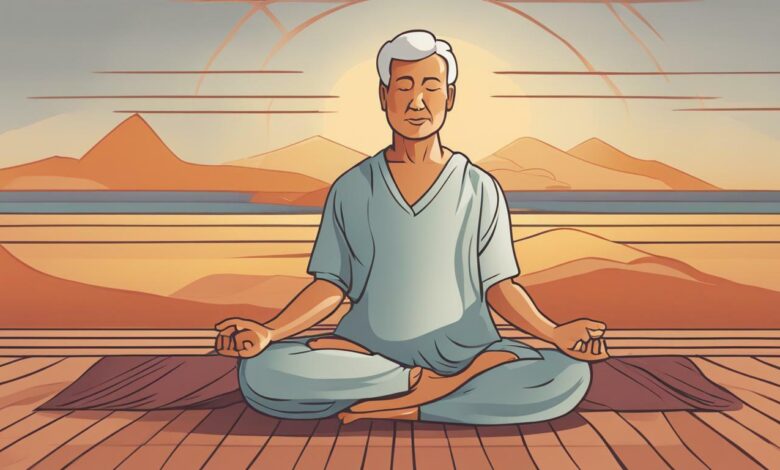Living Well with Arthritis: Non-Medication Approaches

Arthritis is a common condition that affects millions of people worldwide. While medication can help manage the symptoms, it is not the only approach. Non-medication approaches can play a crucial role in managing arthritis and improving joint health.
Managing arthritis without medication means adopting lifestyle changes that can reduce inflammation, alleviate pain, and promote joint function. This approach can not only improve the quality of life for individuals with arthritis but also reduce the risk of long-term complications.
Key Takeaways
- Medication is not the only option for managing arthritis.
- Non-medication approaches can reduce inflammation, alleviate pain, and promote joint function.
- Managing arthritis without medication can improve the overall quality of life and reduce the risk of long-term complications.
Understanding Arthritis and Its Impact on Joint Health
Arthritis is a common condition that affects millions of people worldwide, causing joint pain, stiffness, and inflammation. There are several types of arthritis, including osteoarthritis, rheumatoid arthritis, and gout, each with its own unique causes and symptoms.
Arthritis affects joint health by causing damage to the cartilage, a smooth and flexible tissue that covers the ends of the bones, allowing them to glide over each other without friction. With arthritis, the cartilage wears away, causing the bones to rub against each other, resulting in pain, swelling, and loss of mobility.
Arthritis can also impact other areas of your overall health, such as your mental and emotional well-being, as chronic pain can lead to depression, anxiety, and social isolation.
It’s crucial to understand the impact of arthritis on joint health to develop an effective management plan that addresses all aspects of the condition.
Non-Medication Approaches for Managing Arthritis
If you’re living with arthritis, you don’t always have to rely on medication to manage the pain and discomfort. Exploring non-medication approaches for managing arthritis can be a game-changer for your overall joint health and quality of life. Let’s take a look at some of the approaches you can try:
Dietary Changes
One of the most effective ways to manage arthritis without medication is to make dietary changes. Certain foods can help reduce inflammation, which is often the root cause of joint pain. The Mediterranean diet, which emphasizes fruits, vegetables, whole grains, fish, and healthy fats, has been shown to be especially helpful for managing arthritis. Avoiding processed and high-fat foods can also help you maintain a healthy weight, which can reduce the stress on your joints.
Exercise Routines and Joint Flexibility
Regular exercise can do wonders for managing arthritis pain and reducing inflammation. Low-impact exercises such as swimming, cycling, and yoga can improve joint flexibility, build muscle strength, and reduce pain. Range-of-motion exercises and stretching can also be incredibly helpful in maintaining joint function. Just be sure to consult with a healthcare professional before starting any exercise program to avoid injury and ensure that you are engaging in safe and effective activities.
Joint Protection Techniques
Protecting your joints is essential in managing arthritis without medication. Simple techniques such as adjusting your posture, using assistive devices, and avoiding repetitive motions can help reduce the stress on your joints and prevent further damage. Wearing supportive shoes and using cushioned mats can also be helpful in reducing the impact on your joints while standing or walking.
Exploring non-medication approaches for managing arthritis can be a game-changer for your overall health and quality of life. By making dietary changes, engaging in regular exercise, and protecting your joints, you can reduce joint pain, improve joint function, and avoid the side effects of medication. Be sure to consult with a healthcare professional for personalized guidance and support in your arthritis management journey.
Dietary Changes for Arthritis Management
If you are managing arthritis without medication, dietary changes can play a critical role in reducing inflammation, alleviating joint pain, and promoting overall joint health.
While there is no one-size-fits-all diet for arthritis, some general guidelines can help you make informed choices.
Here are some dietary changes you may want to consider:
- Incorporate more anti-inflammatory foods in your diet, such as fatty fish, nuts, olive oil, and fruits and vegetables.
- Limit or avoid pro-inflammatory foods, such as processed meats, sugary drinks, refined carbohydrates, and saturated and trans fats.
- Maintain a healthy weight to reduce the stress on your joints.
Consulting with a registered dietitian may help you develop a personalized plan based on your individual needs and preferences.
Here’s a sample menu that may help you manage arthritis:
| Meal | Foods |
|---|---|
| Breakfast | Oatmeal with fresh berries and almonds |
| Lunch | Salmon salad with mixed greens, olive oil, and balsamic vinegar dressing |
| Dinner | Vegetable stir-fry with tofu and brown rice |
| Snack | Carrot sticks with hummus |
Remember to talk to your healthcare provider before making any significant changes to your diet and lifestyle to ensure that they are safe and appropriate for you.
Exercise Routines and Joint Flexibility
Regular exercise is essential for managing arthritis without medication. Exercise can help maintain joint flexibility, reduce inflammation, and strengthen the muscles around the joints.
Low-impact exercises such as walking, swimming, and cycling are excellent options for individuals with arthritis. These activities are gentle on the joints and can improve cardiovascular health and overall fitness.
Stretching exercises can also improve joint flexibility and reduce pain. Incorporating yoga or Pilates into your exercise routine can be beneficial for individuals with arthritis as they promote joint mobility and relaxation.
Strength training is another vital aspect of managing arthritis without medication. Resistance exercises can help increase muscle strength, improve joint stability, and reduce the risk of falls. It is crucial to consult with a healthcare professional before starting any exercise program to ensure it is safe and effective for your specific needs.
Remember to warm up before starting your exercise routine and to cool down afterward. This can help prevent injury and reduce soreness. Also, take breaks as needed and listen to your body. If you experience pain or discomfort, adjust your routine or consult with your healthcare professional.
- Maintain joint flexibility
- Reduce inflammation
- Strengthen the muscles around the joints
Incorporating regular exercise into your daily routine can help manage arthritis without medication. Remember to consult with a healthcare professional before starting any exercise program, and listen to your body to adjust your routine as needed.
Joint Protection Techniques
If you have arthritis, protecting your joints is key to maintaining function and reducing pain. Here are some joint protection techniques that can help you manage your arthritis without medication:
- Avoid repetitive motions that put stress on your joints, such as typing or gripping tightly.
- When lifting objects, use the larger joints in your body, such as your shoulders and hips, instead of your fingers or wrists.
- Use assistive devices, such as jar openers or grip bars, to decrease strain on your joints.
- Practice good posture to distribute your weight evenly and avoid unnecessary stress on your joints.
- Modify your sleeping positions to reduce joint pain. For example, use a pillow to support your knees if you sleep on your back.
- Take frequent breaks during activities to avoid overusing your joints.
- Engage in low-impact exercises, such as swimming or cycling, that do not put excessive strain on your joints.
By incorporating these joint protection techniques into your daily routine, you can reduce joint pain and maximize function without relying on medication.
Conclusion
Managing arthritis without medication is a viable option for individuals seeking to manage their condition. Non-medication approaches such as dietary changes, exercise routines, and joint protection techniques can relieve pain and promote joint health, improving the overall quality of life. However, it’s essential to consult with a healthcare professional before embarking on any management program to ensure it’s safe and effective for your individual needs.
Remember that managing arthritis is a journey, and it requires commitment and patience. By exploring non-medication approaches and seeking necessary guidance, you can take control of your condition and live a fulfilling life.
So, start taking steps today towards managing your arthritis without medication. Consulting with a healthcare professional can provide you with a personalized management plan that suits your needs, helping you achieve the best possible outcome.
Managing arthritis without medication is doable, and it all starts with taking that first step!
FAQ
Q: What are non-medication approaches for managing arthritis?
A: Non-medication approaches for managing arthritis include dietary changes, exercise routines, and joint protection techniques.
Q: How does arthritis impact joint health?
A: Arthritis can cause joint pain, stiffness, and inflammation, which can lead to limited mobility and decreased quality of life.
Q: What dietary changes can help manage arthritis?
A: Dietary changes that can help manage arthritis include consuming foods that reduce inflammation and promote joint health. Maintaining a healthy weight is also important.
Q: What exercises can improve joint flexibility and reduce inflammation?
A: Specific exercises and routines, such as low-impact activities and stretching exercises, can improve joint flexibility and reduce inflammation in individuals with arthritis.
Q: What are joint protection techniques?
A: Joint protection techniques involve modifying daily activities, using assistive devices, and practicing proper body mechanics to minimize joint pain and maintain joint function.




